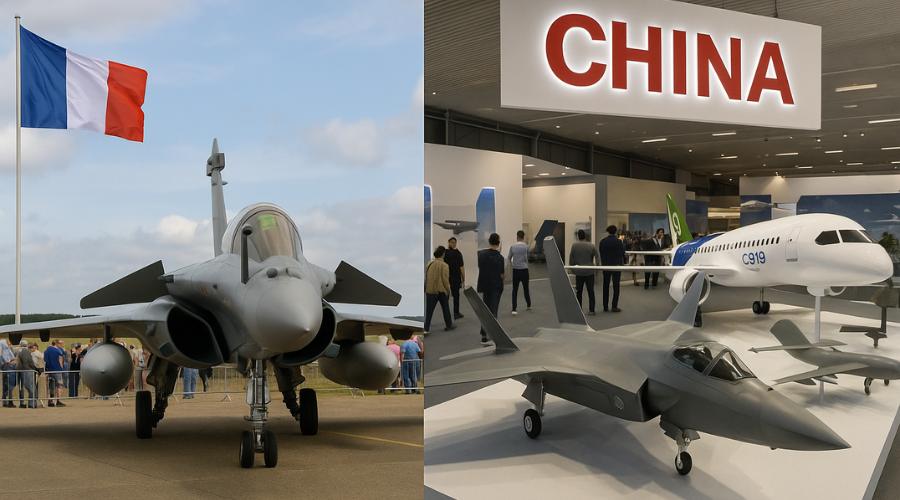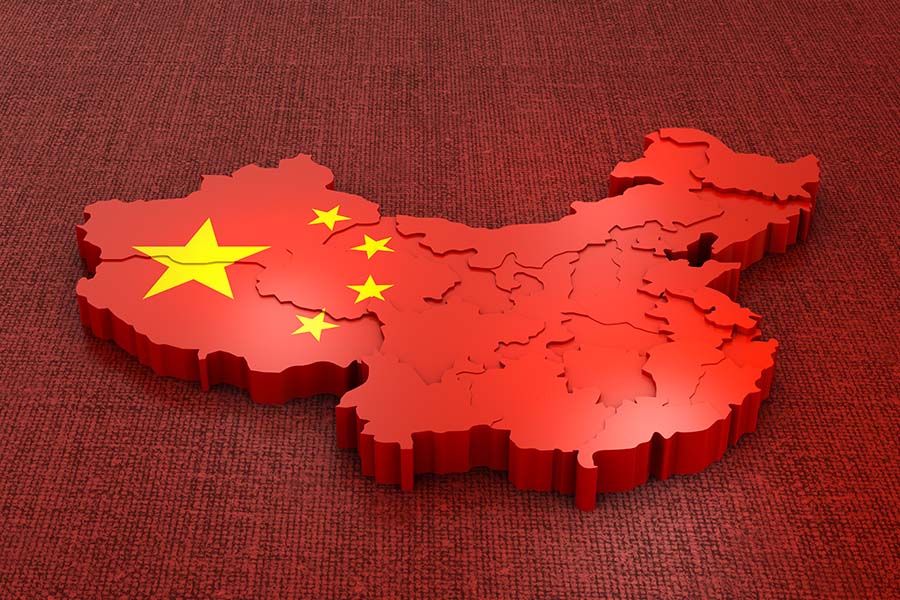Beijing’s Growing Military Supply Ambitions on Display at Paris Air Show

Article paru sur le site The Epoch Time le 21 juin 2025
Cet article paru dans la version américaine de la publication The Epoch Time, mentionne les contributions d’une interview de Gérard Vespierre.
Collaborant depuis plusieurs années avec la publication française, cette parution dans la version américaine est une première. C’est à ce titre qu’elle est reprise sur le site du Monde Décrypté.
Many of the 76 Chinese companies in attendance were first-time participants, underscoring CCP’s determination to expand its footprint in Europe’s aerospace.
Etienne Fauchaire
6/23/2025|Updated: 6/23/2025
PARIS—The 55th edition of the Paris Air Show concluded this Sunday, capping a week marked by geopolitical undertones. And this year, China played a prominent role in the event.
Held biennially at Le Bourget Airport, just outside Paris, the event is the world’s largest and most prestigious gathering in the aerospace and defense sectors.
Historically, the Chinese regime’s presence at the Paris Air Show had been relatively discreet, typically limited to a small number of state-controlled companies. But the 2025 edition marked a turning point: The number of Chinese exhibitors more than doubled, rising from 29 in 2023 to 76 this year, according to GIFAS, the French aerospace industry association that organizes the event.
This year’s show was held between June 16 and June 22. Mock-ups and models crowded the exhibition halls, illustrating the breadth of China’s aeronautics industry, from commercial airliners to military jets and unmanned aerial vehicles (UAVs).
The C919 passenger jet of the Commercial Aircraft Corporation of China (COMAC) shared the spotlight with the Aviation Industry Corporation of China (AVIC), China’s state-run aviation conglomerate, which displayed an array of aircraft and UAVs, including the J-10CE, J-35A, and J-20 fighters, the Y-20 military transport aircraft, the Z-20 helicopter, and the GJ-11 stealth UAV.
Civilian unmanned systems such as the Wing Loong series and the Xuange helicopter series were showcased, alongside specialized platforms, including the AG600M firefighting seaplane and the AC352 mid-sized utility helicopter, co-developed with France-based Airbus. In total, AVIC presented more than 30 models across eight aerospace categories.
First-Time Exhibitors Signal Strategic Intent
Many of the 76 Chinese companies in attendance were first-time participants, underscoring the determination of the Chinese Communist Party (CCP) to expand its footprint in Europe’s aerospace landscape.
Organizers of the Paris Air Show told The Epoch Times that they do not comment on the presence of Chinese companies.
“Whether Chinese or not, if you’re part of the aerospace industry, you want to be at the Paris Air Show,” Emmanuel Lincot, a French sinologist, professor at the Catholic Institute of Paris, and senior research fellow at the Institute for International and Strategic Relations, told The Epoch Times.
“For China, it’s clearly a golden opportunity to gain visibility and influence.”
French geopolitical analyst and researcher Gérard Vespierre emphasized the dual rationale behind the strong Chinese presence.
“There’s a communication dimension, and there’s a political one,“ he told The Epoch Times. ”As the world’s foremost aerospace gathering, the Paris Air Show offers China a unique platform to assert its ambitions on the global stage.”
Strategic Messaging, Gaullist Undertone
The Epoch Times has observed that Chinese suppliers voiced support for bilateral cooperation with France, emphasizing economic opportunities, rejecting what were characterized as unfair portrayals of China, and attributing negative consequences in Europe in areas such as energy to U.S.-led geopolitical decisions.
Chinese suppliers also tried to paint the picture of a commercial landscape made more difficult by U.S. President Donald Trump’s reciprocal tariffs, with the expectation that conditions should improve once his term concludes.
“The Chinese adopt a Gaullist tone and, as usual, appeal to the divergences of interest between allies,” Lincot said.
“France and the United States share common values, but not always the same economic interests.
“Similarly, while France and China do not share the same values, they share common economic interests, in agri-food, luxury goods, or aerospace.”
Military Sales: Still Off-Limits
While the suppliers acknowledged current U.S. and NATO restrictions on Chinese military aerospace exports to Europe, they were cautiously optimistic that the situation could evolve over the long term. For now, however, such prospects appear remote, according to Vespierre.
“I don’t see any Chinese military product breaking into the European market,“ he said. ”NATO remains a cohesive and impermeable bloc in that regard.”
Still, Lincot suggested that global crises might one day challenge that status quo.
“Throughout the history of mankind, when the world is in turmoil, two sectors thrive: luxury goods and armaments. That’s a telling indicator,” he noted.
“From that standpoint, a reconsideration of the arms embargo imposed on China since the Tiananmen massacre in 1989 would not be entirely surprising.”
France, Germany, and the United Kingdom led serious efforts to lift the ban between 2003 and 2005. The EU’s arms embargo on the CCP, imposed on June 27, 1989, in response to the Tiananmen Square Massacre, remains politically binding but is not codified in law, unlike the U.S. embargo. The European initiative to lift the embargo, spearheaded by Paris, was ultimately shelved due to strong opposition from Washington.
COMAC’s C919: China Eyes European Aviation Market
The 2025 Paris Air Show was expected to mark a major step forward for China’s aerospace ambitions with the anticipated debut of the COMAC C919, a narrow-body jet designed to rival the Airbus A320 and Boeing 737. Some attendees hoped for an in-flight demonstration on Airbus’s home turf.
Although organizers invited COMAC to participate and France was prepared to authorize the flight, the European Union Aviation Safety Agency (EASA) did not grant the necessary exemption. COMAC’s presence at the Paris Air Show was, thus, limited to a scale model.
At the show, COMAC signed a memorandum of understanding with French company Safran and the U.S.-based Crane Aerospace for future collaboration on the in-development C929.
“The main challenge for China today is to commercialize its C919 internationally by getting it certified,” Patrick Devaux, a former Airbus executive and aerospace specialist, told The Epoch Times.
In April, EASA Director Florent Guillermet told French magazine L’Usine Nouvelle that certification of the C919 could be granted within “three to six years,” but the approval is inevitable. The certification is being handled under the 2019 Bilateral Aviation Safety Agreement between the EU and China. Guillermet said COMAC has not applied for certification from the U.S. Federal Aviation Administration, the magazine reported.
EASA certification is essential for unlocking markets in Asia, Africa, and beyond.
The C919: Innovation or Industrial Imitation?
However, despite being presented as a flagship of Chinese engineering, the C919 still relies heavily on Western technology—about 80 percent of its components are sourced from American or European suppliers, including LEAP engines developed jointly by French group Safran and GE Aerospace, according to GIFAS.
Also, skepticism lingers about the C919’s originality. Devaux told The Epoch Times that the jet strongly resembles the Airbus A320. He recalled that an A320 sold to China disappeared from operational tracking in the early 2000s and was most likely reverse-engineered.
“When the C919 appeared, we immediately thought, this is an A320,” he said. “No one imagined they would put an aircraft in a hangar, disassemble it entirely, and copy it. You could call it counterfeiting.”
French media reported that Airbus chose not to make the case public because it was wary of damaging commercial ties with China.
Devaux said the company has since adopted tighter safeguards for research and development.
U.S. intelligence agencies regard industrial espionage emanating from the CCP as a top national security threat to the United States. In 2022, a U.S. court sentenced Chinese intelligence officer Xu Yanjun to 20 years in prison for attempting to steal trade secrets from GE Aviation and Safran, both of which supply critical systems to the C919.


